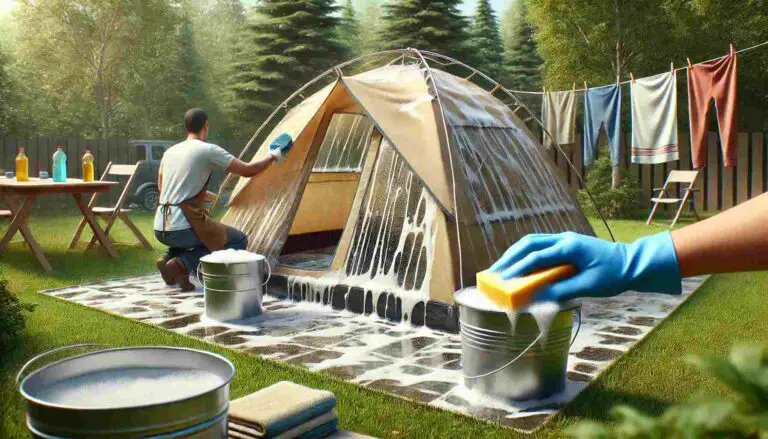Are tents waterproof? This is a common question asked by outdoor enthusiasts, campers, and backpackers. The last thing anyone wants is to get caught in a sudden rainstorm only to find out that their tent is not waterproof. Knowing whether or not tents are waterproof is crucial when planning any outdoor adventure.
The answer to the question “Are tents waterproof?” is not a simple one. While many tents are designed to be waterproof, their effectiveness can be influenced by several factors, including age, material, seams, design, and external factors such as weather conditions. A good quality waterproof tent should be able to withstand heavy rain and prevent water from seeping through. However, no tent is 100% impermeable, and regular maintenance, such as reapplying waterproof coatings and using seam sealer, is necessary to ensure that the tent remains waterproof. Testing the waterproofing of your tent through a hose test, bucket test, or real-world camping trip is also important to ensure that it will keep you dry during wet conditions.
in this post, I will explore the answer to this question in depth. I will discuss what waterproofing means, the different types of tents and materials used, techniques for waterproofing, testing the waterproofing of tents, factors affecting waterproofing, and tips for maintaining waterproofing. By the end of this post, you will have a clear understanding of whether or not tents are waterproof and how to ensure you have a dry and comfortable camping experience. Let’s get to it!
What does Waterproof Mean?
Before we dive into whether or not tents are waterproof, it’s important to understand what waterproofing actually means. Simply put, waterproofing is the process of making something resistant to the penetration of water. In the case of tents, this means that the material used to construct the tent is treated or designed in a way that prevents water from seeping through.
This is especially important for outdoor enthusiasts, as a waterproof tent can mean the difference between a dry and comfortable night’s sleep or a wet and miserable one. It’s important to note that while a tent may be labeled as “waterproof,” no tent is 100% impermeable. However, a good waterproof tent should be able to withstand heavy rain and prevent water from seeping in.
Types of Tents
There are several types of tents available in the market, each with its own unique features and design. Below are some of the most common types of tents:
- Dome Tents: These tents are characterized by their dome-like shape and are popular for their sturdiness and ability to withstand high winds. They are generally easy to set up and can accommodate 2-4 people.
- Cabin Tents: Cabin tents are larger and more spacious than dome tents, and can accommodate up to 10 people. They are designed with straight walls that maximize headroom and living space, making them ideal for family camping trips.
- Backpacking Tents: Backpacking tents are lightweight and compact, designed to be easily carried in a backpack. They are ideal for backpackers and hikers who need to keep their gear as light as possible.
- Pop-up Tents: These tents are designed for quick and easy setup and are ideal for festival-goers or anyone who needs to set up camp quickly. They can be set up in a matter of seconds and typically accommodate 2-4 people.
- Tunnel Tents: Tunnel tents are long and narrow and are designed to maximize living space. They are ideal for larger groups and families, as they can accommodate up to 6 people.
These are just a few of the most common types of tents available in the market. Each type of tent has its own unique features and benefits, and choosing the right one for your needs will depend on a variety of factors, including the number of people in your party, the conditions you’ll be camping in, and your budget.
Waterproofing Techniques
There are several techniques used to waterproof tents. Here are some of the most common techniques:
- Coating: One of the most common techniques for waterproofing tents is to apply a waterproof coating to the material. This can be done using a variety of materials, such as silicone, polyurethane, or acrylic. The coating fills the gaps in the fabric, making it impermeable to water.
- Taped Seams: Another common technique is to use waterproof tape to seal the seams of the tent. This prevents water from seeping through the small holes created when the fabric is stitched together.
- Welded Seams: Welded seams involve bonding two pieces of material together using heat and pressure. This creates a strong, waterproof seal that is less likely to break down over time than taped seams.
- Waterproof Zippers: Zippers can be a weak point in a tent’s waterproofing, as they can allow water to seep through. To combat this, some tents feature waterproof zippers that prevent water from entering through the zipper teeth.
- Waterproof Footprint: A waterproof footprint is a separate piece of material that is placed under the tent to protect it from moisture on the ground. This can be especially important in wet conditions or when camping on damp ground.
Each of these techniques has its own advantages and disadvantages, and the best technique for waterproofing a tent will depend on the type of tent and the conditions it will be used in. It’s important to choose a tent with effective waterproofing techniques to ensure a dry and comfortable camping experience.
Testing the Waterproofing of Tents
Testing the waterproofing of a tent is an important step in ensuring that it will keep you dry during a rainstorm. Here are some ways to test the waterproofing of your tent:
- Hose Test: One simple way to test the waterproofing of your tent is to use a garden hose. Set up your tent in your backyard and spray it with water from the hose, paying close attention to the seams and zippers. If water seeps through, it may be time to reapply a waterproof coating or use seam sealer.
- Bucket Test: Another way to test the waterproofing of your tent is to create a simulated rainstorm. Fill a bucket with water and pour it over the tent, paying attention to areas where water may pool, such as the rainfly. If water seeps through, it may be time to reapply a waterproof coating or use seam sealer.
- Camping Trip: The best way to test the waterproofing of your tent is to take it on a camping trip in wet conditions. This will give you a real-world test of its ability to keep you dry. Be sure to set up your tent correctly and use a waterproof footprint to prevent moisture from seeping through the bottom of the tent.
It’s important to note that even a waterproof tent may develop leaks over time or in extreme weather conditions. Regular maintenance, such as reapplying waterproof coatings and using seam sealer, can help extend the life of your tent’s waterproofing.
Factors Affecting Waterproofing
Several factors can affect the waterproofing of a tent, including:
- Age: Over time, the waterproofing of a tent can break down due to exposure to the elements, UV rays, and general wear and tear. This can lead to leaks and moisture seeping through the fabric.
- Material: The type of material used in a tent can also affect its waterproofing ability. Some materials, such as nylon, are naturally more waterproof than others. However, even the most waterproof materials can become less effective over time or if they are not treated with a waterproof coating.
- Seams: Seams are a common weak point in a tent’s waterproofing. If the seams are not sealed properly, water can seep through the small holes created by the stitching. Seam sealers can be used to fill these gaps and prevent water from entering.
- Design: The design of a tent can also affect its waterproofing ability. Tents with a lower profile are less likely to be affected by wind and rain, while tents with a higher profile may be more vulnerable.
- External Factors: External factors such as heavy rain, high winds, and flooding can all affect the waterproofing of a tent. In extreme conditions, even the most waterproof tent may develop leaks or fail to keep you dry.
It’s important to choose a tent with effective waterproofing features and to take care of it through regular maintenance to ensure it continues to keep you dry during your outdoor adventures.
Conclusion
In conclusion, the question of whether or not tents are waterproof is not a simple one. While many tents are labeled as “waterproof,” the effectiveness of their waterproofing can be affected by several factors, including age, material, seams, design, and external factors. It’s important to choose a tent with effective waterproofing features, such as a waterproof coating, taped or welded seams, and waterproof zippers. Regular maintenance, such as reapplying waterproof coatings and using seam sealer, can help extend the life of your tent’s waterproofing.
Finally, testing the waterproofing of your tent through a hose test, bucket test, or real-world camping trip can help ensure that it will keep you dry during wet conditions. With the right tent and proper care, you can enjoy a dry and comfortable camping experience, no matter what the weather brings.



